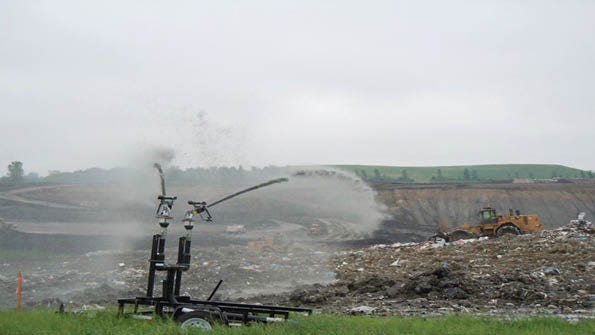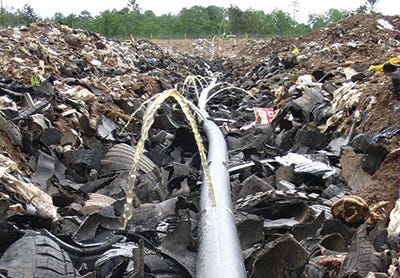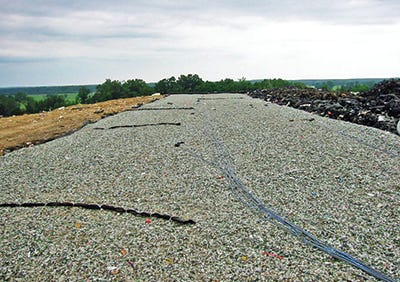December 28, 2014
Fred Doran, P.E.
Leachate poses a challenge for landfill owners and operators, but not an insurmountable one. Such a complex solution—fluid containing compounds both inorganic and organic, from arsenic to xylene—prompts the need for management solutions that protect the community, the environment and the budgets that finance waste disposal operations.
Technologies, strategies, benefits, risks and other conditions should be considered when deciding what course to pursue for managing leachate in a landfill.
Diversion
The first method for reducing problems in leachate is to prevent and divert potentially troublesome materials from being disposed in the landfill in the first place.
Strategies include the promotion and operation of programs that collect pharmaceuticals, electronics, paints, appliances, batteries and other household hazardous. Proper handling of these materials can eliminate problems before they surface.
 Landfill owners should also develop rigorous waste acceptance and inspection programs to minimize the amount of hazardous material that enters the site. Programs can include an application process that requires generators of industrial waste to provide sources and chemical information to verify that material is not hazardous or prohibited for disposal. It is also prudent for landfill-scale attendants and operators to inspect loads as they enter the facility as well as when they are tipped at the working face. This diligence provides a last line of defense to remove unacceptable waste.
Landfill owners should also develop rigorous waste acceptance and inspection programs to minimize the amount of hazardous material that enters the site. Programs can include an application process that requires generators of industrial waste to provide sources and chemical information to verify that material is not hazardous or prohibited for disposal. It is also prudent for landfill-scale attendants and operators to inspect loads as they enter the facility as well as when they are tipped at the working face. This diligence provides a last line of defense to remove unacceptable waste.
Pretreatment
Once in the landfill, natural biological and chemical processes begin degrading the waste, with contaminates leaching with precipitation to the underlying collection system. This chemical cocktail can contain elevated concentrations of biochemical oxygen demand (BOD), chemical oxygen demand (COD), metals, and volatile organic compounds (VOCs). Depending on the method of disposal, concentration reduction may be required to meet publicly-owned treatment works (POTW) pretreatment standards, surface water standards for on-site treatment systems, or groundwater standards for land-based application.
Several methods of pretreatment are available to meet these disposal standards, including surface ponds, biological reactors (e.g. sequencing batch reactors), physical/chemical plants, constructed wetlands and reverse osmosis. Besides physical, chemical and biological reduction, these methods can also transform contaminants to less-harmful forms, such as the conversion of ammonia nitrogen to nitrogen gas through a nitrification-denitrification process.
At the Crow Wing County Landfill in Brainerd, Minn., leachate is collected in four ponds that together form a system allowing for primary treatment, secondary treatment and long-term storage. Such storage becomes critical during winter periods and periods of heavy rain, allowing management of all generated leachate on site. Treatment is provided through mechanical aeration with surface propeller aspirator aerators. Adding methanol as a carbon source to the leachate helps promote denitrification, or the anoxic biological transformation from nitrate to nitrogen gas. The county has also used an all-natural product containing sucrose, other sugars, organic non-sugars and water—derived from the processing of sugar beets—as a carbon source.
Land application
Leachate that has been collected and pretreated may be strategically applied to the land itself. Grasses and trees can absorb certain contaminants like metals, nitrogen and VOCs, while expelling the moisture through phytoremediation. For example, willows and hybrid poplars—with dense root structures and broad leaves for evapotranspiration—have been shown to remove, degrade and safely release materials from leachate. Other leachate constituents affix themselves to the soil surface through adsorption, or are retained by plants or sequestered within the soil.
 The natural process has shown positive results at landfills in Maryland, Oregon and elsewhere. At the St. Louis County Landfill, near Virginia, Minn., for example, pretreated leachate is applied to a dedicated 22.5-acre field planted with reed canary grass. More than 3.8 million gallons of leachate were land-applied during the 2013 growing season via impact sprinklers. The leachate’s total nitrogen load falls within approved limits for a growing season, with crops being cut three times.
The natural process has shown positive results at landfills in Maryland, Oregon and elsewhere. At the St. Louis County Landfill, near Virginia, Minn., for example, pretreated leachate is applied to a dedicated 22.5-acre field planted with reed canary grass. More than 3.8 million gallons of leachate were land-applied during the 2013 growing season via impact sprinklers. The leachate’s total nitrogen load falls within approved limits for a growing season, with crops being cut three times.
Recirculation
Another tool in the leachate management toolbox is leachate recirculation. Using a series of manifold horizontal pipes within the waste, and/or spray application directly to the working face, treated or untreated leachate can be delivered back into the waste to improve conditions. Consider the potential benefits:
Accelerated degradation: While water can be a complicating factor for any landfill operation, it can also be regarded as a welcome resource. Moisture helps speed the breakdown of organic materials. Proper moisture levels can increase the rate of decay up to two to three times. If allowed by regulation, surface water, wastewater and greywater—along with sludge, biosolids and liquid industrial waste—are potential components in creating a bioreactor that promotes microbial activity in the waste. This degradation improves leachate quality and produces a more inert waste condition as the landfill reaches capacity.
Faster waste stabilization: Water is heavy. The additional weight, in concert with the biological breakdown of the waste structure, in turn speeds up the compaction rate within the landfill, further extending the site’s life. Say there’s 1,100 pounds of garbage in a typical cubic yard of waste at a landfill. By recirculating water through the waste, the amount of waste may increase to 1,600 lbs. or even 2,000 lbs. per cubic yard. At the high end, that would approach doubling the useful life of a landfill, optimizing landfill airspace utilization.
Increased gas production: Additional moisture within the waste promotes the generation of methane gas. With proactive collection through horizontal gas laterals and the leachate collection system, the gas can be captured to support an energy recovery project. At the Sioux Falls Landfill near Sioux Falls, S.D., recirculating leachate helps contribute to the collection of more than 2,000 cubic feet per minute of landfill gas. The gas is delivered through a pipeline 11 miles long to an ethanol plant, where it’s is used an alternative to natural gas. The resulting revenue helps the landfill stabilize its tipping fees.
The benefits of time can continue to mount. At the Crow Wing Landfill, for example, operators achieved leachate stability (as measured with a BOD/COD ratio less than 0.2) three years after embarking on a recirculation strategy, an improvement from the typical 10 years to 20 years necessary when using a “dry tomb” approach.
Evaporation
Particularly in drier climates, leachate evaporation is a common volume-reduction technique. Operators can use a large-surface-area storage pond. Other evaporative methods that have recently taken hold in northern climates include the following two approaches, both of which are being used successfully by the Sioux Falls Landfill.
Spray application on the working face or intermediate cover over lined areas using impact sprayers or commercial misters, similar to snow-making equipment.
Using a pump system in a storage pond to spray leachate over the water surface or by dripping the leachate onto the pond’s exposed geomembrane liner along the perimeter. When sprayed onto the liner — black, heavy plastic that has been heated by the sun—leachate runs down the coating. As water evaporates, the volume of the leachate is reduced.
Wetlands
Constructed wetlands also provide an option for leachate treatment and disposal. A lined submerged wetland, for example, can serve as a treatment wetland by using its own natural plant and soil processes to break down contaminants. This can include the addition of aerated zones to promote aerobic and anaerobic treatment of BOD, VOCs, and nitrogen. From there, leachate then can be moved into in a seepage wetland, where carbon, nitrogen, metals and more can be further removed by plant species before percolating into the subsurface.
Hauling
 The goal of treating and otherwise managing leachate on-site is to minimize hauling it away for treatment and disposal elsewhere. Hauling is both an operational challenge and can increase both monetary and environmental expenses. In 2013, for example, Sioux Falls hauled 7.8 million gallons of leachate to its POTW. The 25-mile round trips added up, resulting in over 90,000 lbs. of CO2 emissions. The city is looking at phytoremediation to reduce the hauling impacts.
The goal of treating and otherwise managing leachate on-site is to minimize hauling it away for treatment and disposal elsewhere. Hauling is both an operational challenge and can increase both monetary and environmental expenses. In 2013, for example, Sioux Falls hauled 7.8 million gallons of leachate to its POTW. The 25-mile round trips added up, resulting in over 90,000 lbs. of CO2 emissions. The city is looking at phytoremediation to reduce the hauling impacts.
Looking ahead
Since the requirement of landfill liners was legislated more than two decades ago, landfill professionals have been faced with the need to treat and dispose of leachate. Innovative practices lead to positive results for accelerating waste stabilization, enhancing production of landfill gas, and reducing the volume of leachate that must be treated.
In Crow County, for example, the total cost for implementing the first 11 years of recirculation strategies, compared with revenues and avoided expenses, resulted in net savings of $2.8 million.
Determining precisely how to proceed with leachate initiatives depends on a number of factors, including climate, soil conditions, regulatory requirements and waste character. And there’s also the future to consider. Aside from potentially extending the life of a landfill, leachate recirculation and bioreactor systems can help reduce post-closure financial assurance obligations.
Fred Doran is a department manager in the Environmental Group at Burns & McDonnell, where he leads solid waste projects with particular experience with leachate and landfill gas management systems.
You May Also Like


.png?width=300&auto=webp&quality=80&disable=upscale)